
Most volcanic activity on Mercury stopped about 3.5 billion years ago
New research from North Carolina State University finds that major volcanic activity on the innermost planet most likely ended about 3.5 billion years ago — in stark contrast to the volcanic ages found for Venus, Mars and Earth. These findings add insight into the geological evolution of Mercury and what happens when rocky planets cool and contract.









